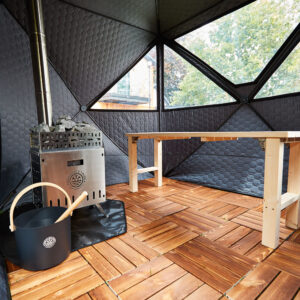
Ice Baths: A Key to Enhanced Recovery and Vitality for Athletes
Explore how ice baths can boost recovery and enhance vitality for athletes. Discover practical tips and insights to elevate your performance. Read more!
Spend Over £500 To Get Free UK Delivery - Excludes Certain Postcodes & Round Ice Baths
Delivery to Ireland now available

Stepping into a sauna can transform your wellness routine, but knowing exactly how long to stay is crucial for both safety and effectiveness. Whether you’re a first-time user or an experienced sauna enthusiast, the duration of your sauna session significantly affects the health benefits you’ll receive.
For most healthy adults, research consistently points to 15-20 minutes as the sweet spot for sauna sessions. This timeframe provides maximum benefits while maintaining safety margins that protect against overheating and dehydration.
The Finnish sauna tradition, which has guided sauna bathing for thousands of years, emphasises leaving when you feel “hot enough” rather than adhering to strict timing. This intuitive approach recognises that individual tolerance varies and that listening to your body’s signals takes precedence over watching the clock.
Beginners should start conservatively with 5-10 minute sessions. Your first few sauna experiences should focus on acclimatisation rather than duration. The intense dry heat of a traditional sauna or the penetrating warmth of an infrared sauna can feel overwhelming initially, and shorter sessions allow your cardiovascular system and thermoregulatory mechanisms to adapt gradually.
A structured progression schedule for building tolerance typically follows this pattern:
For experienced sauna users who have built heat tolerance over months or years, the maximum safe duration extends to approximately 30 minutes per session. However, this upper limit requires proper hydration protocols, regular cooling breaks, and careful attention to warning signs.
The key principle underlying all duration recommendations is responsiveness to bodily signals. Exit the sauna immediately if you experience dizziness, lightheadedness, nausea, excessive fatigue, or any discomfort, regardless of how much time has elapsed.
Different sauna types create distinct thermal environments that directly impact how long you can safely stay in a sauna. Understanding these differences helps you optimise your sauna experience based on the specific heat delivery method and environmental conditions.
Recommended Duration | Temperature Range | Humidity Level | Maximum Safe Duration | Key Characteristics | |
|---|---|---|---|---|---|
Traditional Finnish | 10-15 min (beginners), 15-20 min (regular) | 160-200°F (70-93°C) | 10-20% (dry) | 30 min (experienced) | High heat, aggressive sweating, shorter stays |
Infrared Sauna | 15-30 min (beginners/regular) | 110-150°F (43-65°C) | ~10-20% (dry) | 45 min (experienced) | Lower air temp, longer sessions tolerated |
Steam Room | 10-20 min (all levels) | 110-120°F (43-49°C) | ~100% (saturated) | 20 min | Humidity intensifies heat perception |
Traditional saunas generate intense dry heat that rapidly induces sweating and elevates core body temperature. The combination of high temperatures and low humidity creates an environment where heat stress builds quickly, necessitating shorter session durations. The sauna rocks retain and radiate heat efficiently, creating the characteristic intense heat that Finnish saunas are known for.
Infrared saunas allow for significantly longer sessions because they heat the body directly through infrared light rather than heating the ambient air to extreme temperatures. This direct heating method means you can experience substantial sweating and cardiovascular benefits at lower air temperatures, reducing the risk of acute overheating. Many experienced sauna users find infrared sauna use more comfortable for extended periods, making 30-45 minute sessions feasible.
Steam rooms present a unique challenge due to their saturated humidity environment. While air temperatures remain relatively moderate, the 100% humidity prevents effective sweat evaporation, making the wet heat feel more intense than the actual temperature suggests. This humid environment typically limits comfortable sessions to 10-20 minutes, regardless of experience level.

Age significantly affects how long you should stay in a sauna due to changes in cardiovascular function, thermoregulation, and fluid balance that occur over time.
Older adults over 65 face increased risks during sauna bathing due to reduced cardiovascular reserve and compromised temperature regulation. The aging process naturally decreases the body’s ability to dissipate heat efficiently, and many older adults take medications that can interfere with normal thermoregulatory responses. For this demographic, limiting sauna sessions to 10-15 minutes provides substantial health benefits while minimising risks of dehydration and heat-related complications.
Children and adolescents present special considerations for sauna use. Their immature thermoregulatory systems and proportionally smaller fluid reserves make them particularly vulnerable to rapid dehydration and overheating. Most health experts advise against sauna use for very young children, while older children and teenagers may participate in carefully supervised sessions limited to 5-10 minutes maximum.
Body composition also influences heat tolerance and optimal session duration. Individuals with higher body fat percentages may experience slower heat dissipation, potentially increasing overheating risk and necessitating shorter sessions. Conversely, those with more muscle mass often adapt more quickly to heat stress but should still follow gradual progression protocols.
Several health conditions require medical consultation before determining appropriate sauna duration, and some may contraindicate sauna use entirely.
Cardiovascular disease demands particular caution. While research suggests that regular sauna bathing can benefit stable, chronic heart conditions, individuals with acute cardiac issues, uncontrolled arrhythmias, recent heart attacks, or unstable angina should avoid sauna use. Those with controlled cardiovascular conditions may safely enjoy shorter sauna sessions (10-15 minutes) with physician approval.
High blood pressure presents a complex scenario. Sauna bathing typically causes temporary blood pressure reductions post-session, but the acute heat stress can initially cause blood pressure fluctuations that may be problematic for individuals with uncontrolled hypertension. Conservative session durations and careful monitoring are essential for maintaining healthy blood pressure responses.
Respiratory conditions like asthma or COPD can be exacerbated by high heat and humidity, particularly in steam rooms. These individuals should start with very brief exposures (5 minutes) and may find infrared saunas more tolerable than traditional high-heat environments.
Pregnancy requires special consideration, as prolonged exposure to high temperatures may pose risks to fetal development, particularly during the first trimester. Pregnant women should consult their healthcare providers and, if approved, limit sessions to very brief, mild exposures.
Medication interactions can significantly affect sauna tolerance. Diuretics, beta-blockers, antihistamines, and certain psychiatric medications can impair temperature regulation or fluid balance, increasing the risk of dehydration and overheating even during shorter sessions.
Heat acclimatisation is a physiological adaptation that develops over weeks to months of regular sauna exposure. This adaptation involves improved cardiovascular efficiency, enhanced sweating response, and better electrolyte conservation.
Beginning sauna users lack these adaptations and should follow conservative progression schedules. Starting with 5-10 minute sessions allows the cardiovascular system to adapt gradually to heat stress without overwhelming the body’s compensatory mechanisms.
Signs that indicate readiness to increase session duration include:
Experienced sauna users who have developed heat acclimatisation can safely extend sessions toward the 20-30 minute range, provided they maintain proper hydration and remain attentive to warning signs. However, even experienced users should approach longer sessions gradually and never ignore bodily signals in favour of achieving arbitrary time goals.

Different health objectives may benefit from specific sauna durations, though individual responses vary and these recommendations should be combined with personalised medical advice.
Muscle recovery benefits from 15-30 minute sessions, particularly when timed after exercise. The increased blood flow and heat therapy effects help reduce muscle soreness and accelerate the removal of metabolic waste products. Athletes and fitness enthusiasts often find that daily or near-daily sauna sessions enhance recovery between training sessions.
Cardiovascular health improvements are most strongly supported by research examining 20-minute sessions at approximately 55°C (131°F), conducted 4-7 times weekly. A landmark Finnish cohort study published in JAMA Internal Medicine found that frequent sauna use at these parameters correlated with up to 40% reduction in all-cause and cardiovascular mortality. The cardiovascular system benefits from the controlled heat stress that mimics moderate exercise responses.
Stress relief and mental health benefits typically emerge from 15-20 minute sessions that allow sufficient time for cortisol reduction and endorphin release. The deep relaxation that comes from sustained heat exposure can improve sleep quality and provide significant pain relief for individuals dealing with chronic pain conditions.
Detoxification through enhanced sweating reaches optimal levels during 15-25 minute sessions, though the clinical significance of toxin elimination through sweat remains debated in medical literature. The primary detoxification benefits likely come from improved circulation and lymphatic drainage rather than direct toxin excretion.
Weight management applications may benefit from longer sessions (25-45 minutes) at moderate temperatures, as extended heat exposure increases heart rate and energy expenditure. However, sauna-induced weight loss primarily reflects fluid loss, and any metabolic benefits are modest compared to traditional exercise.
Skin health improvements can result from 15-minute sessions conducted twice weekly. The increased circulation and gentle sweating may support collagen production and help cleanse pores, though these effects are generally cosmetic rather than medical.
Recognising early warning signs of heat stress is crucial for safe sauna use, regardless of how much time you intended to spend in the sauna session.
Immediate exit signs include:
These symptoms represent your body’s warning system alerting you to potentially dangerous overheating or dehydration. Ignoring these signals significantly increases the risk of heat exhaustion, heat stroke, or cardiovascular complications.
The principle of listening to your body supersedes any predetermined time goals. An experienced sauna user might need to exit after 10 minutes on a day when they’re dehydrated or stressed, while a beginner might comfortably tolerate 15 minutes when well-hydrated and rested.

For those progressing toward longer sauna sessions, implementing comprehensive safety protocols becomes increasingly important.
Hydration protocols form the foundation of safe extended sauna use. Drink 2-4 glasses (16-32 ounces) of water before entering the sauna room, and maintain fluid intake afterwards. During longer sessions, consider brief exits every 15 minutes for rehydration and cooling.
Cooling breaks become essential for sessions exceeding 20 minutes. Step outside the sauna room to allow your heart rate to normalise and core temperature to stabilise. Some users prefer alternating between the sauna and a cold shower or ice bath, though this practice requires additional caution regarding blood pressure fluctuations.
Avoid alcohol and caffeine before sauna bathing, as both substances cause dehydration and impair your body’s natural heat tolerance mechanisms. These substances also affect cardiovascular responses to heat stress, potentially masking important warning signs.
Gradual progression remains crucial even for those seeking longer sessions. Add only 2-5 minutes per week to your routine, and be prepared to reduce duration if you experience any adverse symptoms.
Appropriate attire includes sitting on clean towels and wearing minimal, loose-fitting clothing. Remove metal jewellery and accessories that can become hot enough to cause burns.
Never sauna alone when attempting longer or more intense sessions. Having someone nearby becomes increasingly important as session duration extends, particularly for individuals with any health conditions.
Exceeding safe sauna duration can lead to several serious health complications that range from uncomfortable to potentially life-threatening.
Dehydration represents the most common danger from extended sauna exposure. High-temperature saunas can produce 1-2 litres of sweat per hour, rapidly depleting body fluids and leading to reduced plasma volume, headaches, muscle cramping, and impaired cognitive function.
Heat exhaustion and heat stroke develop when core body temperature rises beyond the body’s compensatory mechanisms. Heat exhaustion symptoms include heavy sweating, weakness, nausea, and headache, while heat stroke involves elevated core temperature (≥104°F/40°C), confusion, and potential loss of consciousness. Heat stroke constitutes a medical emergency requiring immediate intervention.
Cardiovascular stress increases with prolonged exposure as the heart works harder to maintain circulation and temperature regulation. This stress can be particularly dangerous for individuals with underlying heart conditions or high blood pressure.
Male fertility may be temporarily affected by excessive heat exposure, as elevated testicular temperatures can reduce sperm production and motility. These effects are typically reversible but may persist for several weeks after cessation of excessive heat exposure.
Blood pressure fluctuations can occur both during and after extended sauna sessions. The combination of heat-induced vasodilation and fluid loss can cause significant blood pressure drops when transitioning to cooler environments, potentially leading to fainting or falls.
Electrolyte imbalances result from excessive sweating without adequate replacement of fluids and minerals. Severe imbalances can affect muscle function, heart rhythm, and neurological function.
Establishing a sustainable, safe sauna practice requires patience, consistency, and attention to your body’s responses.
Weeks 1-2: Begin with 5-10 minute sessions every other day. Focus primarily on becoming comfortable with the heat environment and establishing proper hydration habits. Use this period to experiment with different seating positions and breathing techniques.
Weeks 3-4: Progress to 10-15 minute sessions while maintaining the same frequency. Begin to notice how your body responds to the increased duration and adjust based on your comfort level.
Month 2: Advance to 15-20 minute sessions and consider increasing frequency to daily use if well-tolerated. This period typically represents when most health benefits become noticeable.
Long-term routine: Settle into 20-30 minute sessions based on individual tolerance, health goals, and schedule constraints. Many long-term sauna users find that 4-7 sessions weekly provide optimal benefits while remaining sustainable.
Rest days remain important even for experienced users. Schedule at least 1-2 days weekly without sauna use to allow full recovery and prevent adaptation plateaus.
Progress tracking helps optimise your routine over time. Note session duration, subjective comfort level, post-sauna energy, sleep quality, and any symptoms. This information helps identify optimal timing and frequency for your individual needs.
Regular routine adjustments may be necessary based on seasonal changes, illness, travel, or life stress. Flexibility in your approach ensures long-term adherence and continued safety.

How long should a beginner stay in a sauna for the first time?
Beginners should limit their first sauna session to 5-10 minutes maximum. This conservative approach allows your cardiovascular system and heat regulation mechanisms to adapt gradually without overwhelming your body. Even if you feel comfortable, resist the urge to extend your first session, as heat tolerance builds over time through repeated exposure.
Can you stay in an infrared sauna longer than a traditional sauna?
Yes, infrared saunas typically allow for longer sessions than traditional saunas. While traditional Finnish saunas generally limit sessions to 15-30 minutes due to high air temperatures (160-200°F), infrared saunas operate at lower temperatures (110-150°F) and heat the body directly. This allows experienced users to safely extend infrared sauna sessions to 30-45 minutes while receiving similar health benefits.
Is it safe to use a sauna daily for 20 minutes?
Daily sauna use for 20 minutes is generally safe for healthy adults and is supported by extensive Finnish population studies. Research shows that frequent sauna use (4-7 times weekly) correlates with significant cardiovascular and all-cause mortality benefits. However, maintain proper hydration, listen to your body’s signals, and consider rest days if you experience fatigue or other symptoms.
What’s the maximum time you should ever spend in a sauna?
The maximum safe duration for experienced sauna users is approximately 30 minutes per session in traditional saunas, with some tolerance for longer sessions (up to 45 minutes) in infrared saunas. These limits assume proper hydration, regular cooling breaks, and careful attention to warning signs. Exceeding these durations significantly increases risks of dehydration, heat exhaustion, and cardiovascular stress.
How long should you wait between sauna sessions?
Allow at least a few hours between sauna sessions to ensure complete rehydration and physiological recovery. If you prefer multiple rounds in a single visit, separate them by 15-30 minutes of cooling and fluid replacement. Daily sessions are acceptable, but full rehydration should occur before each new session.
Does sauna temperature affect how long you can stay in?
Absolutely. Higher temperatures require shorter session durations due to increased heat stress and faster core temperature elevation. Traditional saunas at 160-200°F typically limit sessions to 15-30 minutes, while infrared saunas at 110-150°F allow longer exposures. Steam rooms, despite lower air temperatures, feel hotter due to humidity and generally limit sessions to 10-20 minutes.
Should you take breaks during longer sauna sessions?
Yes, taking breaks during longer sessions (over 15-20 minutes) is recommended for safety. Exit the sauna every 10-15 minutes to cool down, rehydrate, and allow your heart rate to normalise. These breaks help prevent progressive overheating and maintain the therapeutic benefits while minimising risks.
How do you know if you’ve been in the sauna too long?
Warning signs of excessive sauna exposure include dizziness, nausea, rapid or irregular heartbeat, excessive fatigue, skin irritation, or difficulty breathing. Any of these symptoms indicate immediate need to exit the sauna, cool down, and rehydrate. Trust your body’s signals over predetermined time goals, as individual tolerance varies based on hydration, health status, and experience level.
Understanding how long to stay in a sauna empowers you to maximise the incredible benefits while prioritising safety. Whether you’re seeking muscle recovery, cardiovascular health improvements, or stress relief, the key lies in gradual progression, proper hydration, and attentive self-monitoring. Start conservatively, build your tolerance systematically, and remember that consistency in shorter, safe sessions provides far greater benefits than occasional extended exposures that risk your health and well-being.

Founder of Urban Ice Tribe

Explore how ice baths can boost recovery and enhance vitality for athletes. Discover practical tips and insights to elevate your performance. Read more!

There’s nothing quite like the raw, elemental power of a pop-up sauna. Portable, authentic, and deeply restorative, it’s the perfect way to reconnect with nature and yourself. But to take your sauna ritual to the next level, the right sauna accessories can make all the difference.

Transform your outdoor space into a personal wellness retreat with the Urban Ice Tribe Sauna Tent. This detailed setup guide walks you through every step, from unboxing to your first steam session, blending practical instruction with the mindful ritual of heat therapy.
Helping men & women release anxieties & limiting beliefs to experience a life of freedom using powerful breathwork, cold water therapy, movement & sound healing.

No spam, notifications only about new products, updates, offers and announcements.